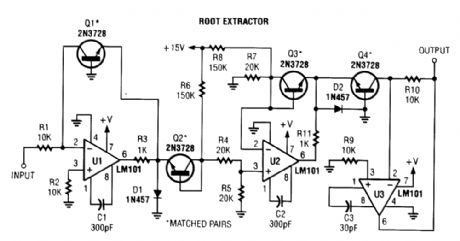
Basic Circuit
Index 354
CW_AUDIO_FILTER
Published:2009/6/18 2:59:00 Author:May

A high-performance passive filter. The center frequency is 700 Hz; -3-dB bandwidth is 200 Hz. (View)
View full Circuit Diagram | Comments | Reading(1019)
TRANSCEIVER_MEMORY_BACKUP
Published:2009/6/18 2:52:00 Author:May

Although designed for a Kenwood TR7730, this idea might be adapted to other transceivers. This circuit will retain the frequencies in memory while moving the rig from car to house and vice versa. When connected to an external power source, battery B1 is charged through R1 and D1.D1 prevents B1 from discharging when connected to an extemal supply that is tumed off. When extemal power is removed, D2 provides a current path to the TR-7730 to retain the memory's contents. However, the TR-7730 power switch should be tumed off before extemal power is removed because B1 will not provide power for normal operation. (View)
View full Circuit Diagram | Comments | Reading(824)
ONE_WATT_CW_TRANSMITTER
Published:2009/6/18 2:49:00 Author:May
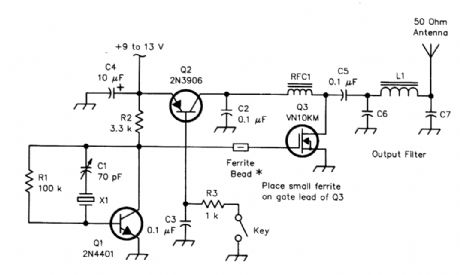
C6,C7 L1820 pF disc ceramic (160 meters) 33 turns,#30, T37-2 (160 meters) 470 pF disc ceramic (80 meters) 23 turns,#30, T37-2 (80 meters) 220 pF disc ceramic (40 meters) 17 turns,#30, T37-2 (40 meters) 150 pF disc ceramic (30 meters) 14 turns,#30, T37-2 (30 meters) 100 pF disc ceramic (20 meters) 12 turns,#30, T37-2 (20 meters) 82 pF disc ceramic (17 meters) 10 turns,#30, T37-2 (17 meters) (View)
View full Circuit Diagram | Comments | Reading(1329)
AUDIBLE_SWR_DETECTOR_ADAPTER
Published:2009/6/18 2:39:00 Author:May
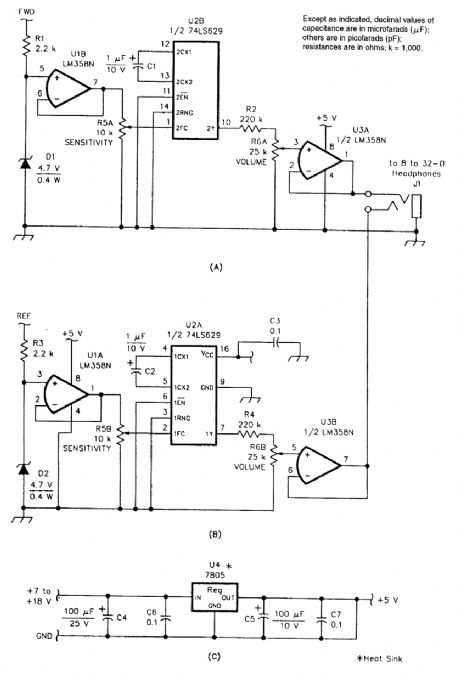
This SWR detector audio adapter is designed specifically for blind or vision-impaired atrtateurs, but anyone can use it. Instead of using a meter (or meters) to indicate antenna system forward and reflected voltages, this adapter generates two tones with frequencies that are proportional to the re-spective voltages. The tones are fed to a pair of stereo headphones (the miniature types are ideal) so that one ear hears the forward-voltage tone and the other ear hears the reflected-voltage tone. Thus, tuning up a transmitter is simply a matter of tuning for the highest-pitched tone in the left ear and the lowest-pitched tone in the right ear. (View)
View full Circuit Diagram | Comments | Reading(807)
45_MHz_IF_AMPLIFIER_WITH_CRYSTAL_FILTER
Published:2009/6/18 2:29:00 Author:May
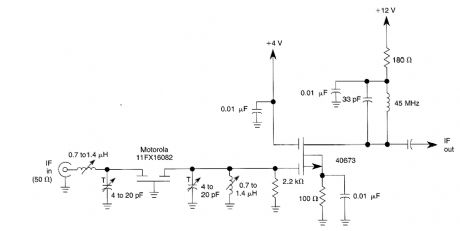
A 40673 dual-gate MOSFET is matched to a crystal filter at 45 MHz. The filter impedance is around 2kΩ. The + 4-V source can be made variable for gain control (about +4 to -4V.) (View)
View full Circuit Diagram | Comments | Reading(1152)
VOLTAGE_LEVEL_CIRCUIT
Published:2009/6/17 21:47:00 Author:May
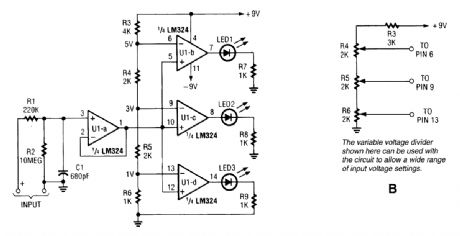
A DC op amp and a comparator with a ladder reference divider allow a dc input voltage to light one or more LEDs, depending on voltage levels. (View)
View full Circuit Diagram | Comments | Reading(1033)
LOGIC_PULSER
Published:2009/6/17 21:24:00 Author:May
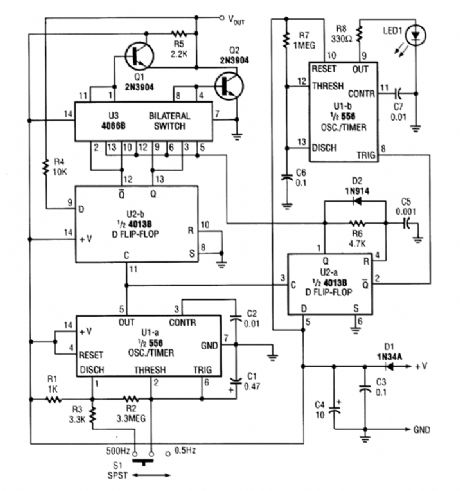
The logic pulser generates pulses at 500 Hz or 0.5 Hz. When the pulser's tip connects to an in-put that is already being driven high or low, the pulser senses the logic state and automatically pulses the input briefly to the opposite state. (View)
View full Circuit Diagram | Comments | Reading(3)
SAFETU_CIRCUIT
Published:2009/6/17 20:41:00 Author:May
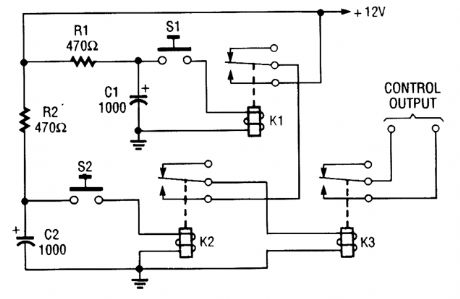
Because of the finite hold-on time of delay circuits R1/C1 and R2/C2, both S1 and S2 must be pressed at the same time to power up the load. (View)
View full Circuit Diagram | Comments | Reading(634)
ELECTRONIC_FUSE
Published:2009/6/17 20:39:00 Author:May
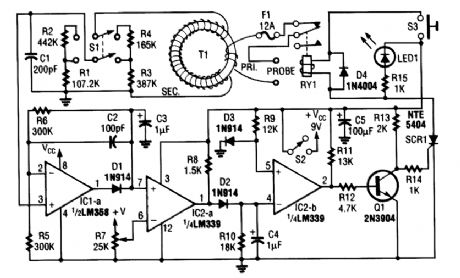
Basically, this circuit is an adjustable electronic circuit breaker, containing a toroidal transformer Lhat senses 60-Hz load current. T1 has a two-turn winding for primary, and 100 turns of #30 gauge wire for the secondary. A high-low range switch selects 0.1 to 6 A or 1 to 12 A. The primary winding of T1 carries fuL load current and voltage; should be suitably insulated, as should be RY1. (View)
View full Circuit Diagram | Comments | Reading(5)
43925_MHz_ATV_DOWNCONVERTER
Published:2009/6/17 4:18:00 Author:May
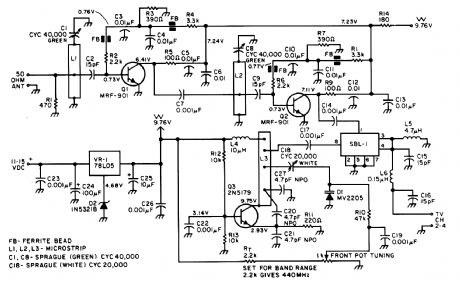
Most ATV (Amateur Television] transmitters transmit a DSB signal and commercial television stations use a VSB (Vestigial Sideband) signal. This fact is made use of in this converter to use the lower sideband. This results in less interference from repeaters that occupy the 440- to 445-MHz por-tion of the band. However, this approach might suffer from VHF image responses from channel 29, if that channel is active in your area. (View)
View full Circuit Diagram | Comments | Reading(854)
ROOT_EXTRACTOR
Published:2009/6/17 3:29:00 Author:May
View full Circuit Diagram | Comments | Reading(0)
6_DIGIT_CODED_ac_POWER_SEITCH
Published:2009/6/17 3:23:00 Author:May
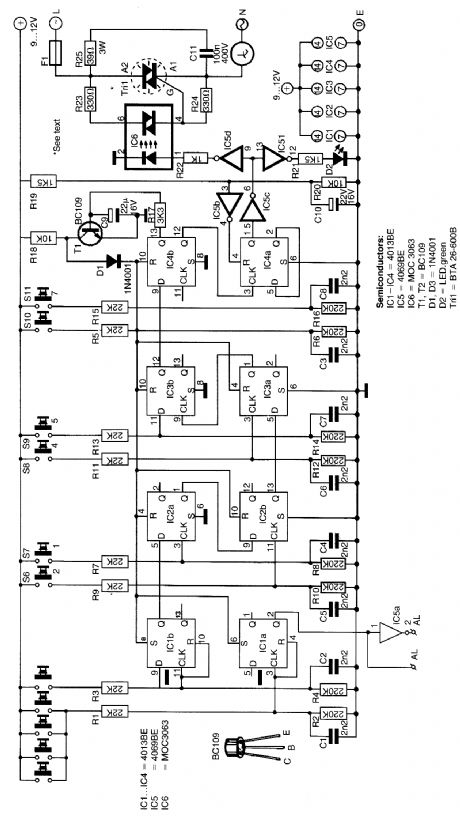
This seitch uses four CD4013 BE dual flip-flops, an inverter, and an optoisolator to drive a triac. The circuit can seitch 25-A ac load cuttrent. A standard 4×3 telephone keybord is used to enter a 6-digit code. In case of a wring cide, a signal is available to activate an alarm. The disarming method is a secret reset button that can be any number on the keyboard. (View)
View full Circuit Diagram | Comments | Reading(1215)
ROOT_EXTRACTOR
Published:2009/6/17 3:19:00 Author:May
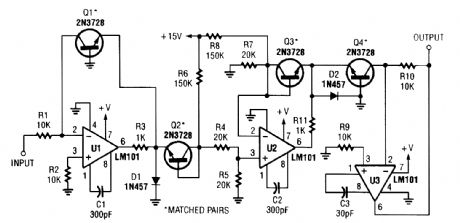
This circuit produces a voltage that is proportional to the root of the input. This gives a logarithmic response,log VINN=N log VIN. (View)
View full Circuit Diagram | Comments | Reading(1247)
LOAD_SENSING_TRIGGER
Published:2009/6/17 3:18:00 Author:May

A device plugged into S01 causes a voltage-limited gate trigger for triac TR1, and causes power to be applied to SC2. (View)
View full Circuit Diagram | Comments | Reading(932)
3_CHANNEL_COLOR_ORGAN
Published:2009/6/17 3:05:00 Author:May
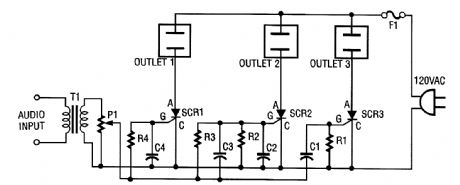
The ac line power is brought back into the circuit through F1, a protective 5-A fuse. One side of the ac line is connected to one side of each ac outlet. The other side of the ac line is connected to each SCR or silicon-controlled rectifier. Each SCR is, in turn, connected to the other side of each ac outlet.An audio signal is brought into the circuit from a stereo speaker by transformer T1. This trans-former has 500-Ω impedance on the primary and 8-Ω impedance on its secondary. Connect T1 so that the 8-Ω side is connected to the speaker and the 500-Ω side is connected to potentiometer P1.Potentiometer P1 is used as a level or sensitivity control. The signal from its wiper lead is applied to each RC filter stage. Because each SCR has a different RC (resistor/capacitor) filter on its gate lead, each will respond to different frequencies. The greater the capacitance in the filter, the lower the frequency that the SCR will respond to. (View)
View full Circuit Diagram | Comments | Reading(2231)
CAPACITANCE_MULTIPLIER
Published:2009/6/17 2:54:00 Author:May
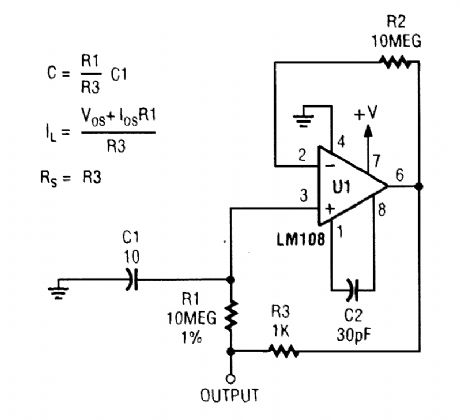
Capacitance multiplier uses the gain of an op amp to produce an effective capacitance-in this case 100,000 μF. (View)
View full Circuit Diagram | Comments | Reading(0)
TRANSISTORIZED_SCHMITT_TRIGGER
Published:2009/6/17 2:49:00 Author:May
View full Circuit Diagram | Comments | Reading(1102)
CODE_PRACTICE_OSCILLATOR_USES_OPTOISOLATOR
Published:2009/6/17 2:37:00 Author:May
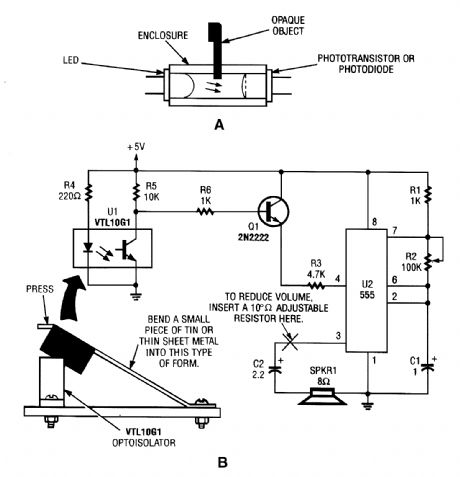
A slotted-pair isolator (A) is effectively an enclosed-pair isolator with a slit that will allow an obstacle to interrupt the light path. That could be useful for building a code key (B). (View)
View full Circuit Diagram | Comments | Reading(918)
CARRIER_CURRENT_BABY_ALERT_RECEIVER
Published:2009/6/17 2:25:00 Author:May
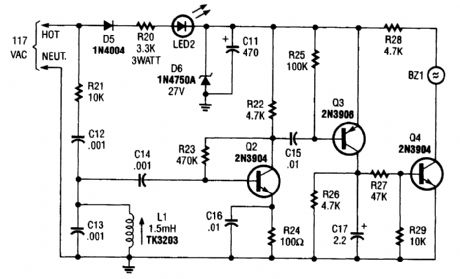
The baby-alert receiver is comprised of three transistors: Q2, which is configured as a high-gain linear amplifier; Q3, which serves as both an amplifier and detector; and Q4, which is essentially used as a switch; and a few additional components. It sounds an alarm BZ1 on receipt of a 125-kHz signal from an alarm transmitter via the 120-V power lines. (View)
View full Circuit Diagram | Comments | Reading(670)
FREQUENCY_MULTIPLIER_WITHOUT_PLL
Published:2009/6/17 1:53:00 Author:May
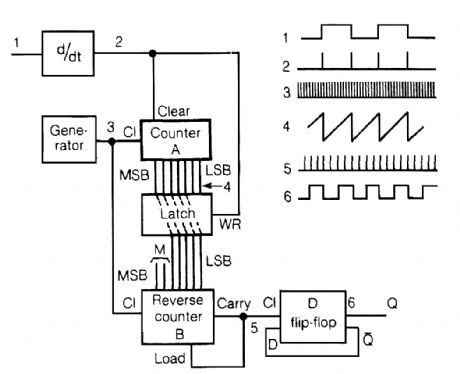
An input rectangular signal is differentiated and short impulses are formed from its edges. These impulses write the content of counter A to a latch that clears the counter after a very short time. Counter A counts impulses of the frequency fo that are much greater than that of the input signal. The pulses come from an impulse generator. Thus, the number, which is written to the latch, expresses the number of these intpulses between the edges of the input signal. The impulses from the same generator pass to (reverse) counter B. The carry impulse loads the content of the latch to counter B. The latch is connected with the reverse counter such that the number written to this counter is 2M times smaller than the number introduced to the latch. This can be readily achieved by omitting M most significant bites of counter B. Because the number loaded to counter B is 2M times smaller than the number in the latch, the carry impulses of counter B have frequency 2M times greater than the frequendy of the impulses at the output of the differentiator. The cany impulses are fed to a D flip-flop, which divides their frequency by two. In this way, the output frequency is 2M greater than input frequency fo as long as the frequency of impulse generator fg is much greater than 2Mfo. (View)
View full Circuit Diagram | Comments | Reading(934)
| Pages:354/471 At 20341342343344345346347348349350351352353354355356357358359360Under 20 |
Circuit Categories
power supply circuit
Amplifier Circuit
Basic Circuit
LED and Light Circuit
Sensor Circuit
Signal Processing
Electrical Equipment Circuit
Control Circuit
Remote Control Circuit
A/D-D/A Converter Circuit
Audio Circuit
Measuring and Test Circuit
Communication Circuit
Computer-Related Circuit
555 Circuit
Automotive Circuit
Repairing Circuit
